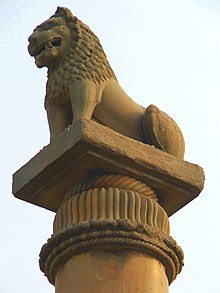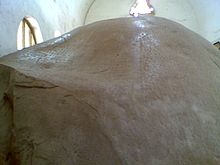Ashoka
Ashoka Maurya (Sanskrit: अशोक मौर्य), (304–232 BCE), commonly known as Ashoka and also as Ashoka the Great, was an Indian emperor of the Maurya Dynasty who ruled almost all of the Indian subcontinent from circa 269 BCE to 232 BCE. One of India's greatest emperors, Ashoka reigned over a realm that stretched from the Hindu Kush mountains in the west to Bengal in the East and covered the entire Indian subcontinent except parts of present day Tamil Nadu and Kerala. The empire's capital was Pataliputra (in Magadha, present-day Bihar), with provincial capitals at Taxila and Ujjain.
In about 260 BCE Ashoka waged a bitterly destructive war against the state of Kalinga (modern Odisha). He conquered Kalinga, which none of his ancestors had done. He embraced Buddhism after witnessing the mass deaths of the Kalinga War, which he himself had waged out of a desire for conquest. "Ashoka reflected on the war in Kalinga, which reportedly had resulted in more than 100,000 deaths and 150,000 deportations."Ashoka converted gradually to Buddhism beginning about 263 BCE.He was later dedicated to the propagation of Buddhism across Asia, and established monuments marking several significant sites in the life of Gautama Buddha. "Ashoka regarded Buddhism as a doctrine that could serve as a cultural foundation for political unity."Ashoka is now remembered as a philanthropic administrator. In the Kalinga edicts, he addresses his people as his "children", and mentions that as a father he desires their good.
Ashoka is referred to as Samraat Chakravartin Ashoka – the "Emperor of Emperors Ashoka." His name "Aśoka" means "painless, without sorrow" in Sanskrit (the a privativum and śoka "pain, distress"). In his edicts, he is referred to as Devānāmpriya (Pali Devānaṃpiya or "The Beloved of the Gods"), and Priyadarśin (Pali Piyadasī or "He who regards everyone with affection"). His fondness for his name's connection to the Saraca asoca tree, or the "Ashoka tree" is also referenced in the Ashokavadana.
H.G. Wells wrote of Ashoka in his book The Outline of History: "Amidst the tens of thousands of names of monarchs that crowd the columns of history, their majesties and graciousnesses and serenities and royal highnesses and the like, the name of Ashoka shines, and shines, almost alone, a star." Along with the Edicts of Ashoka, his legend is related in the 2nd-century Ashokavadana ("Narrative of Ashoka," a part of Divyavadana), and in the Sri Lankan text Mahavamsa ("Great Chronicle"). The emblem of the modern Republic of India is an adaptation of the Lion Capital of Ashoka.
Ashoka's early life
Ashoka was born to the Mauryan emperor Bindusara and a relatively lower ranked wife of his, Dharmā [or Dhammā]. He was the grandson of Chandragupta Maurya, founder of Mauryan dynasty. The Avadana texts mention that his mother was queen Subhadrangī. According to Ashokavadana, she was the daughter of a Brahmin from the city of Champa.Empress Subhadrangī was a Brahmin of the Ajivika sect, and was found to be a suitable match for Emperor Bindusara. Though a palace intrigue kept her away from the emperor, this eventually ended, and she bore a son. It is from her exclamation "I am now without sorrow," that Ashoka got his name. The Divyāvadāna tells a similar story, but gives the name of the queen as Janapadakalyānī.Ashoka had several elder siblings, all of whom were his half-brothers from other wives of Bindusara. His fighting qualities were apparent from an early age and he was given royal military training. He was known as a fearsome hunter, and according to a legend, killed a lion with just a wooden rod. Because of his reputation as a frightening warrior and a heartless general, he was sent to curb the riots in the Avanti province of the Mauryan empire.
Rise to power
Maurya Empire under Ashoka. The empire stretched from Afghanistan to Bengal to South India.
Bindusara's death in 273 BCE led to a war over succession. According to Divyavandana, Bindusara wanted his son Sushim to succeed him but Ashoka was supported by his father's ministers, who found Sushim to be arrogant and disrespectful towards them. A minister named Radhagupta seems to have played an important role in Ashoka's rise to the throne. The Ashokavadana recounts Radhagupta's offering of an old royal elephant to Ashoka for him to ride to the Garden of the Gold Pavilion where King Bindusara would determine his successor. Ashoka later got rid of the legitimate heir to the throne by tricking him into entering a pit filled with live coals. Radhagupta, according to the Ashokavadana, would later be appointed prime minister by Ashoka once he had gained the throne. The Dipavansa and Mahavansa refer to Ashoka's killing 99 of his brothers, sparing only one, named Vitashoka or Tissa, although there is no clear proof about this incident (many such accounts are saturated with mythological elements). The coronation happened in 269 BCE, four years after his succession to the throne.
Early life as emperor
Buddhist legends state that Ashoka was of a wicked nature and bad temper. He also built Ashoka's Hell, an elaborate torture chamber, deemed the "Paradisal Hell" because of its beautiful exterior contrasted with the acts carried out inside by his appointed executioner Girikaa, which earned him the name of "çanḍa Ashoka" or "Chandaashoka," meaning "Ashoka the Fierce" in Sanskrit. Professor Charles Drekmeier cautions that the Buddhist legends intend to dramatise the change that Buddhism brought in him, and therefore, exaggerate Ashoka's past wickedness and his piousness after the conversion.Ascending the throne, Ashoka expanded his empire over the next eight years, from the present-day boundaries Assam in the East to Iran in the West; from the Pamir Knot in the north to the peninsula of southern India except for present day Tamil Nadu and Kerala which were ruled by the three ancient Tamil kingdoms.
Conquest of Kalinga
While the early part of Ashoka's reign was apparently quite bloodthirsty, he became a follower of the Buddha's teachings after his conquest of Kalinga on the east coast of India in the present-day states of Odisha and North Coastal Andhra Pradesh. Kalinga was a state that prided itself on its sovereignty and democracy. With its monarchical parliamentary democracy it was quite an exception in ancient Bharata where there existed the concept of Rajdharma. Rajdharma means the duty of the rulers, which was intrinsically entwined with the concept of bravery and dharma. The Kalinga War happened eight years after his coronation. From his 13th inscription, we come to know that the battle was a massive one and caused the deaths of more than 100,000 soldiers and many civilians who rose up in defence; over 150,000 were deported. When he was walking through the grounds of Kalinga after his conquest, rejoicing in his victory, he was moved by the number of bodies strewn there and the wails of the kith and kin of the dead.Buddhist conversion
| “ | His Majesty feels remorse on account of the conquest of Kalinga because, during the subjugation of a previously unconquered country, slaughter, death, and taking away captive of the people necessarily occur, whereat His Majesty feels profound sorrow and regret. | ” |
Legend says that one day after the war was over, Ashoka ventured out to roam the city and all he could see were burnt houses and scattered corpses. This sight made him sick and he cried the famous monologue:
| “ | What have I done? If this is a victory, what's a defeat then? Is this a victory or a defeat? Is this justice or injustice? Is it gallantry or a rout? Is it valor to kill innocent children and women? Did I do it to widen the empire and for prosperity or to destroy the other's kingdom and splendor? One has lost her husband, someone else a father, someone a child, someone an unborn infant.... What's this debris of the corpses? Are these marks of victory or defeat? Are these vultures, crows, eagles the messengers of death or evil? | ” |
Nevertheless, his patronage led to the expansion of Buddhism in the Mauryan empire and other kingdoms during his rule, and worldwide from about 250 BCE. Prominent in this cause were his son Mahinda (Mahendra) and daughter Sanghamitra (whose name means "friend of the Sangha"), who established Buddhism in Ceylon (now Sri Lanka).
Archaeological evidence for Buddhism between the death of the Buddha and the time of Ashoka is scarce; after the time of Ashoka it is abundant.
Death and legacy
In his old age, he seems to have come under the spell of his youngest wife Tishyaraksha. It is said that she had got Ashoka's son Kunala, the regent in Takshashila and the heir presumptive to the throne, blinded by a wily stratagem. The official executioners spared Kunala and he became a wandering singer accompanied by his favourite wife Kanchanmala. In Pataliputra, Ashoka heard Kunala's song, and realised that Kunala's misfortune may have been a punishment for some past sin of the emperor himself. He condemned Tishyaraksha to death, restoring Kunala to the court. In the Ashokavadana, Kunala is portrayed as forgiving Tishyaraksha, having obtained enlightenment through Buddhist practice. While he urges Ashoka to forgive her as well, Ashoka does not respond with the same forgiveness. Kunala was succeeded by his son, Samprati, but his rule did not last long after Ashoka's death.
The reign of Ashoka Maurya might have disappeared into history as the ages passed by, had he not left behind records of his reign. These records are in the form of sculpted pillars and rocks inscribed with a variety of actions and teachings he wished to be published under his name. The language used for inscription was Prakrit.
In the year 185 BCE, about fifty years after Ashoka's death, the last Maurya ruler, Brihadratha, was assassinated by the commander-in-chief of the Mauryan armed forces, Pushyamitra Sunga, while he was taking the Guard of Honor of his forces. Pushyamitra Sunga founded the Sunga dynasty (185 BCE-78 BCE) and ruled just a fragmented part of the Mauryan Empire. Many of the northwestern territories of the Mauryan Empire (modern-day Afghanistan and Northern Pakistan) became the Indo-Greek Kingdom.
King Ashoka, the third monarch of the Indian Mauryan dynasty, has come to be regarded as one of the most exemplary rulers in world history.





